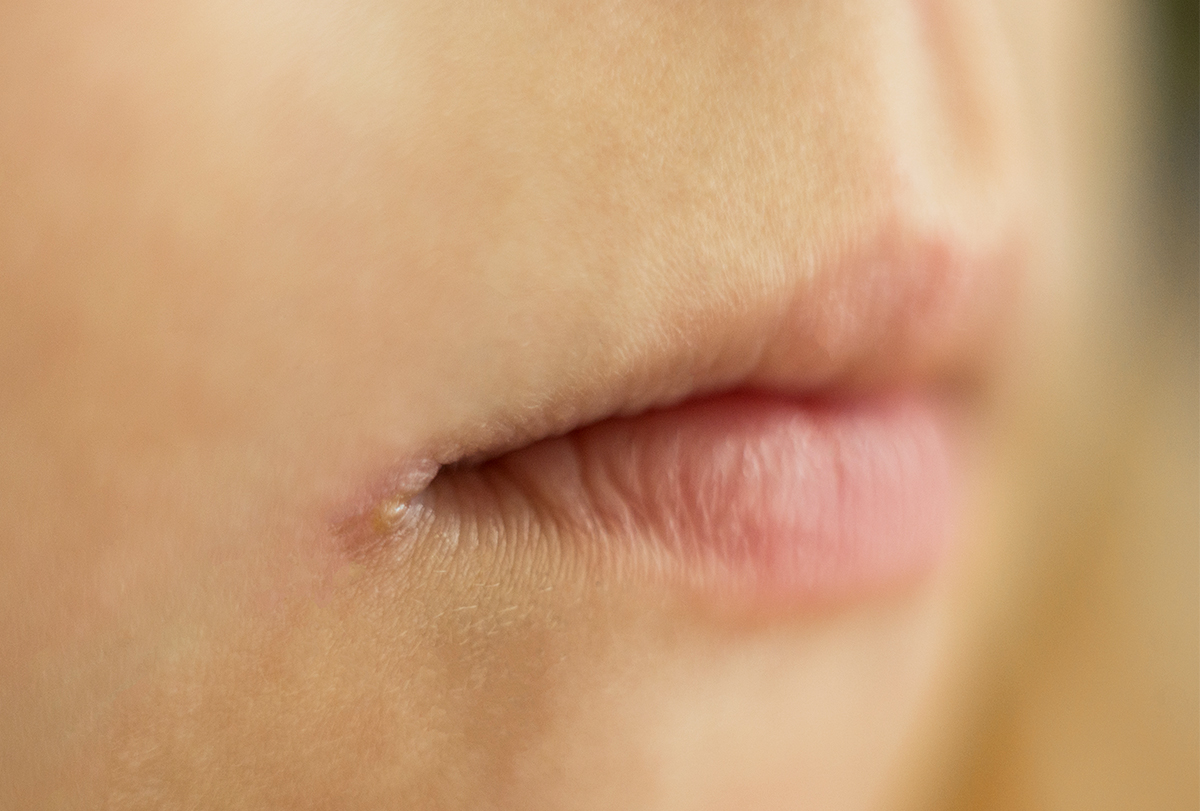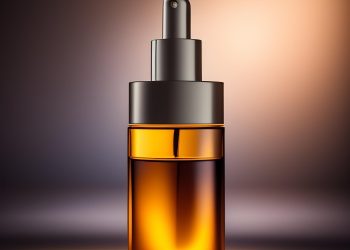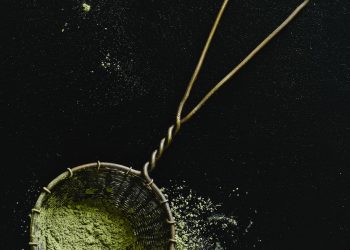Angular cheilitis is not a medical emergency that you should panic about. However, some home remedies for angular cheilitis may help you get rid of this condition quickly.
Angular cheilitis is an inflammation in the corners of the mouth. [1] It’s also known by the names perleche and angular stomatitis. [2]
The inflammation caused due to this condition may even extend to the lips or some parts of the face. But in most cases, it’s seen at one or both corners of the mouth. [1]
One of the first symptoms you’ll notice is irritation and soreness in the corner of your mouth. You’ll also have bleeding, blisters, cracks, crusty, itchy, red, and swollen areas.
But, it can make your daily activities involving the mouth difficult. You may face problems while speaking, eating, and drinking. It’s important to resolve this issue right away.
But keep in mind, there’s no angular cheilitis overnight cure.
Read on to learn the causes and symptoms of angular cheilitis, plus some natural remedies to treat this problem.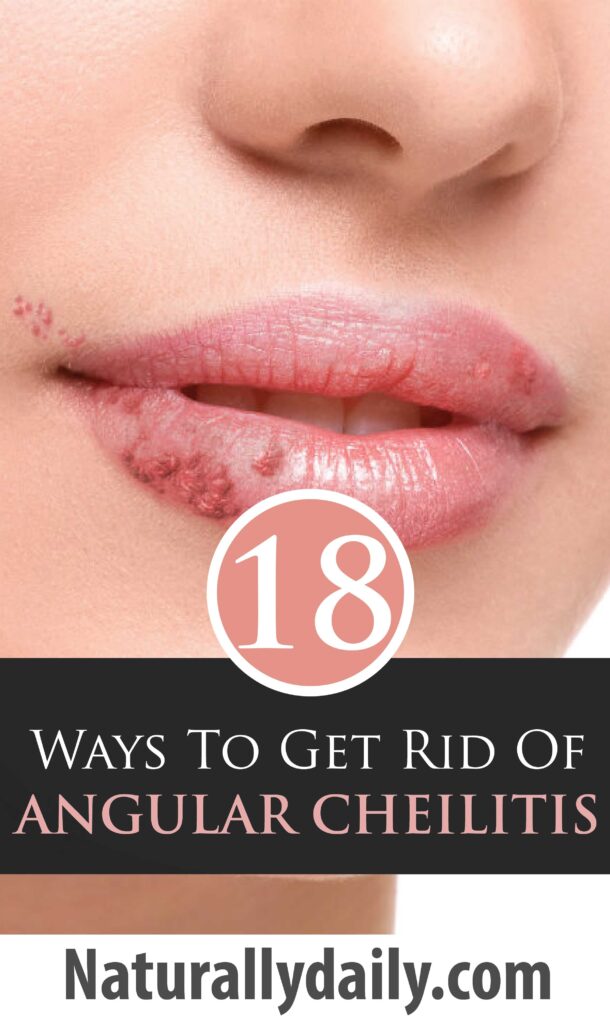
Home Remedies for Angular Cheilitis
1. Aloe Vera
Aloe vera is a popular herbal plant used in cosmetic products and medications [3].
It is famous for its therapeutic effects in Greece, India, Japan, China, and Mexico.
Aloe vera is rich in vitamins, minerals, enzymes, amino acids, salicylic acids, and more.
Aloe vera contains anti-inflammatory and wound healing properties. In addition, it may help in treating angular cheilitis [3].
These properties work to reduce the symptoms. They also speed up the healing of the inflamed lesions on the mouth corners.
Aloe vera can also prevent fungal infection. Because it helps control the growth and spread of Candida albicans [4].
At 10 percent concentration, aloe vera gel can wipe out 90 to 100 percent of Candida albicans.
The way it works is by preventing the tube formation of the fungal strain [5].
How to use aloe vera for angular cheilitis natural treatment:
Put aloe vera leaf in the refrigerator. Slice it into two. Squeeze the end to release the gel. Rub the gel on the corners of the mouth. Let it dry for 15 minutes before washing it off with cool water. Use this remedy every day for three to four weeks.
Read More: 11+ Health Benefits of Aloe Vera Oil (Backed by Scientific Evidence)
2. Tea Tree Oil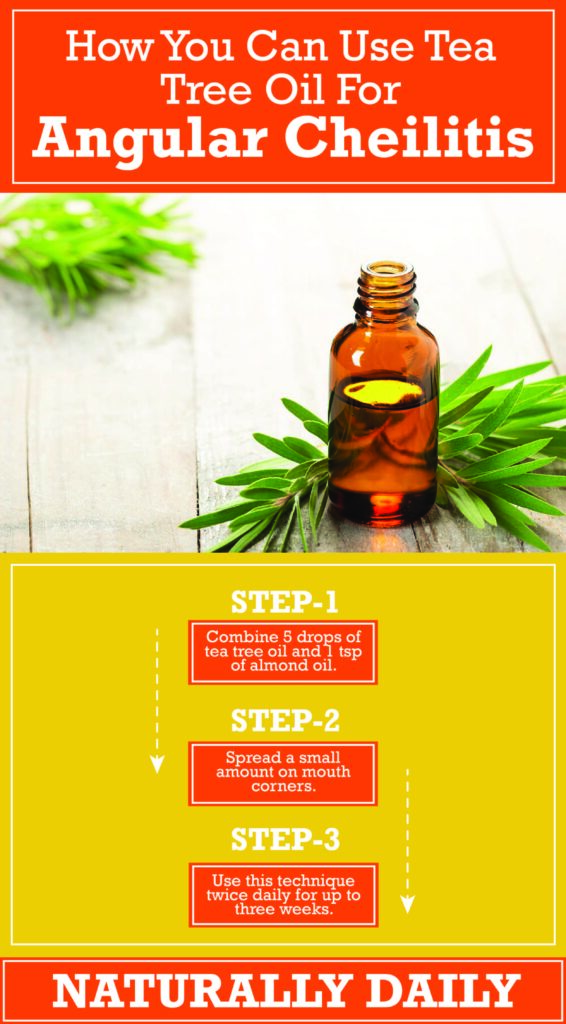
Tea tree oil has become one of the most famed medicinal oils in the world because it has potent pharmacological effects.
In Australia, it is popular as an antiseptic and anti-inflammatory agent [5].
Some microorganisms cause angular cheilitis. It has strong antifungal and antibacterial activities against those microorganisms [6, 7, 8, 9, 10].
It damages the cellular membranes of pathogenic microorganisms [8].
Its fungicidal effects are so strong that it can kill 90 percent of Candida albicans. And the best part is that a small concentration of 0.25 percent can do that [10]. However, susceptible to its antifungal powers are 57 strains of Candida fungi [10].
It also reduces inflammation with its terpinen-4-ol and other active components [11].
These components can suppress the production of pro-inflammatory mediators in the body [11]. Researchers recommend tea tree oil for microbial infections like angular cheilitis [12].
Learn how you can use tea tree oil for angular cheilitis:
Combine 5 drops of tea tree oil and 1 tsp of almond oil. Spread a small amount on mouth corners. Use this technique twice daily for up to three weeks.
Read More: Tea Tree Oil for Skin Tags: 8 Natural Remedies to Try Now!
3. Cucumber
Cucumber is more than just a refreshing addition to your salad.
It has medicinal value that is great for skin issues and inflammation conditions.
Cucumber has cleansing action. It helps eliminate impurities that may worsen the infection in cases of angular cheilitis [13].
It also has cooling effects, which can lessen skin irritation and inflammation [13].
Moreover, it nourishes the skin, keeps it moisturized, and promotes regeneration—all these help boost recoveries from mouth corner cracks [14].
A simple way to use cucumber for angular cheilitis:
Get one slice of cucumber. Press it on the cracked corners of your lips. Do this for 15 minutes every day for three to four weeks.
4. Honey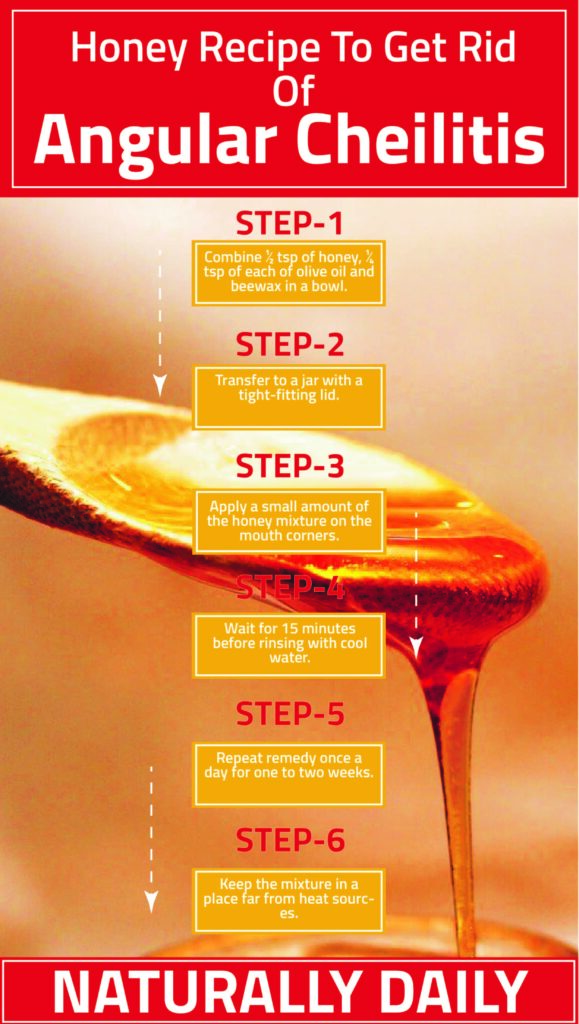
Honey is not just a healthy sweetener.
Staphylococcus aureus and Candida albicans are infection-causing pathogens. However, several studies indicate that honey can destroy these pathogens [15, 16, 17, 18].
Researchers tested a mixture of honey, olive oil, and beeswax. First, they probed the efficacy of the mixture in inhibiting the growth of Staphylococcus aureus and Candida albicans [15]. The mixture prevented the growth of these microbes by 50 to 66 percent. However, when used alone, olive oil and beeswax did not show the same results. Honey is the reason behind the mixture’s antimicrobial activities [15].
On top of these, honey is also a strong anti-inflammatory agent. So, it can improve the condition of angular cheilitis [16]. In addition, it has ellagic, gallic, ferulic acids, myricetin, and caffeic acid. These phenolic compounds can tone down inflammation.
Try this honey recipe to get rid of angular cheilitis:
Combine ½ tsp of honey, ¼ tsp of each olive oil, and beeswax in a bowl. Transfer to a jar with a tight-fitting lid. Apply a small amount of the honey mixture to the mouth corners. Wait for 15 minutes before rinsing with cool water. Repeat the remedy once a day for one to two weeks. Keep the mixture in a place far from heat sources.
Read More: 10 Health Benefits of Honey (Backed by Science)
5. Petroleum Jelly
Many mothers turn to petroleum jelly for treating their babies’ diaper rashes. But, this isn’t the only skin issue that petroleum jelly can take care of. It is one of the oldest treatments for the skin that’s still popular [17]. It is also a reliable remedy for the painful cracks in the corners of the mouth.
Researchers recommend this product to prevent the recurrence of angular cheilitis [18].
You should apply petroleum jelly to the skin folds to keep them moist.
How to use petroleum jelly for angular cheilitis:
Dilute 5 drops of tea tree oil in ½ tsp of petroleum jelly. Apply on inflamed skin. Wait for one hour before wiping it off. Do this several times a day or for up to two weeks.
6. Olive Oil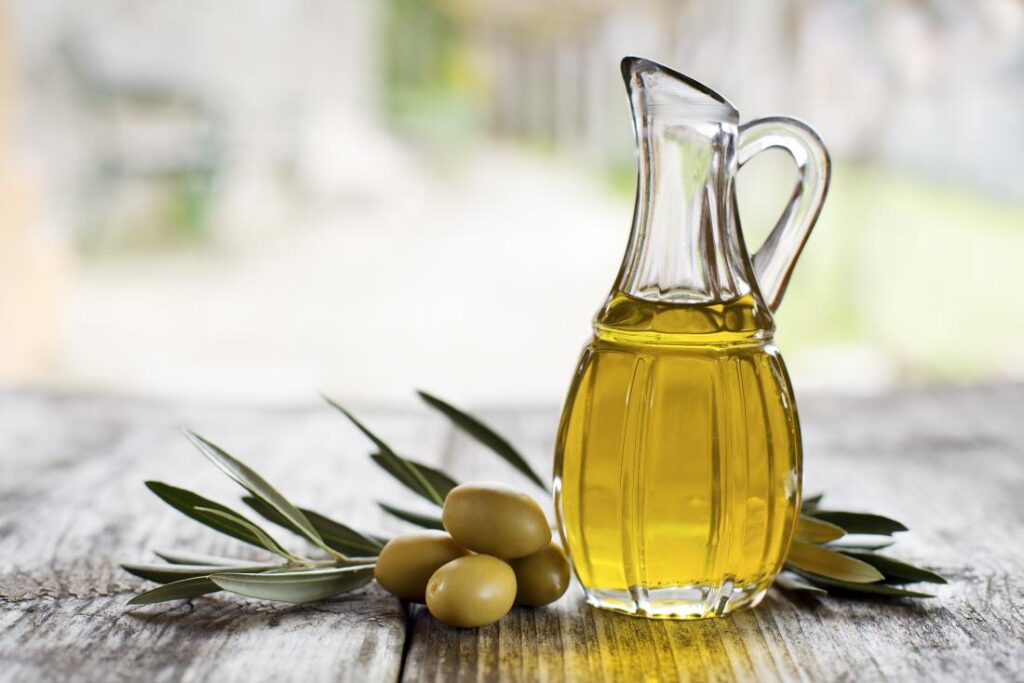
A staple in the Mediterranean diet, olive oil is rich in antioxidants. As a result, it can help keep the body strong and less susceptible to infections [19]. In addition, it’s great for topical use, protects the skin, and keeps it from drying out [20].
As you know, dry skin worsens the mouth corner cracks and makes you more prone to infection. In addition, olive oil has high antimicrobial activities against Staphylococcus aureus [21].
Australian researchers evaluated the antimicrobial effects of an extract obtained from olive leaves. They used broth microdilution and agar dilution methods.
The result shows that its bactericidal properties are strongest against Staphylococcus aureus.
It also works against strains that have become resistant to antibiotics. [21]
This means that if your angular cheilitis keeps on coming back, you should use this remedy.
Here’s how you can use olive oil for angular cheilitis:
Warm 1 tablespoon of olive oil in a pan. Let it cool before applying to mouth lesions. Do the procedure twice a day for three to four weeks.
Read More: How to Use Olive Oil for Skin Health Boost
7. Glycerin
It’s important to keep the skin around the mouth moisturized. It will prevent angular cheilitis from getting worse. One way to do that is with glycerin. A 20 percent glycerin cream formulation is an effective emollient. [22]
Glycerine can help prevent dry skin. It can also relieve itchiness and stinging sensation.
Patients with angular cheilitis complain about these two symptoms most.
Proper management of this condition requires the alleviation of unpleasant symptoms.
Learn how to use glycerin for angular cheilitis:
Rub glycerin on the inflamed skin around the mouth. Follow this remedy three times a day for one to two weeks.
8. Coconut Oil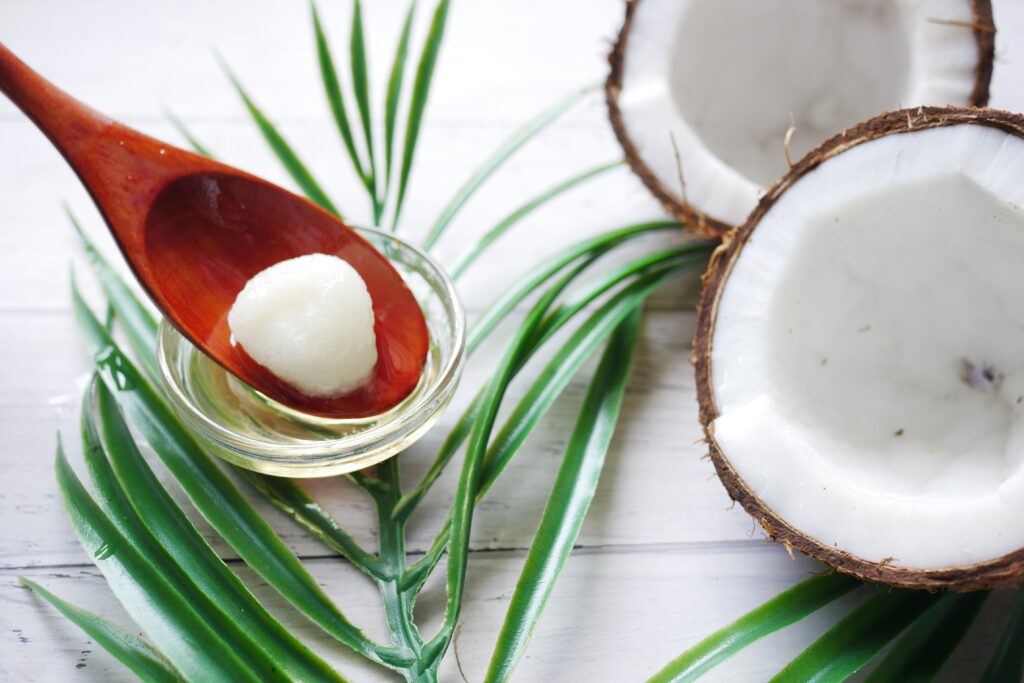
Coconut oil is very useful in reducing the symptoms of skin infections. It can reduce pain and itching [23]. It does so by keeping the skin moisturized. You are applying coconut oil to your mouth corner cracks when you feel uncomfortable. That’s not all that it could do for angular cheilitis sufferers.
It can also prevent bacterial and fungal infections [24, 25, 26].
Coconut oil can prevent the growth and spread of pathogens. As a result, it can also reduce the risk of infection [27, 28, 29].
How you can treat angular cheilitis using coconut oil:
First, apply coconut oil to the affected areas. Then, repeat three to four times a day. Use this remedy for up to three weeks to heal cracked lip corners fast.
Read More: Treat Eczema Naturally with Coconut Oil: 6 Simple Ways to Try Now
9. Neem
Another easy way to control fungal or bacterial infections around the mouth is with neem.
Neem has effective antimicrobial mechanisms against Staphylococcus aureus and Candida albicans [30].
Neem can prevent bacteria and fungi from replicating. It can halt the process of infection.
The reason behind this action is the presence of tannins, polyphenols, and saponins in neem [30].
There have been few reports of adverse reactions from using this herbal remedy. However, you must follow the instructions on preparation and use.
Try neem leaves for angular cheilitis:
Boil ¼ cup of neem leaves in a pot of water. Remove from heat, and then strain. Wash the area around your mouth with this solution. Do this twice a day for one to two weeks.
10. Cocoa Butter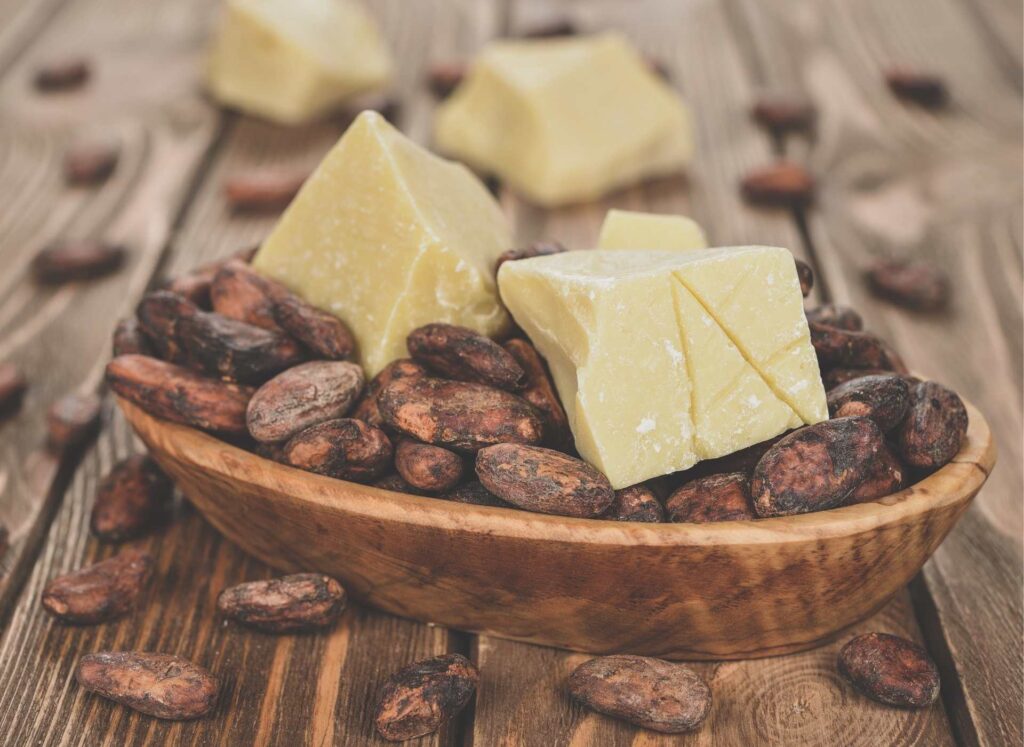
Polyphenols in cocoa butter have a positive effect on the skin. These can promote skin elasticity and regeneration [31]. Unsurprisingly, cocoa butter is a popular ingredient in skin care products.
It’s also great as a moisturizer, keeping the skin around the mouth from getting dry [32].
The more moisturized the mouth corners are, the less chance of an infection. This also prevents the worsening of cracking and inflammation. All these help treat the inflamed lesions caused by angular cheilitis.
Here’s how you may use cocoa butter for angular cheilitis:
Put ¼ tsp of cocoa butter and 3 drops of tea tree oil in a bowl. Mix well. Apply a small amount of cocoa butter mixture to the cracked corners of the mouth. Rinse after 30 minutes. Do this three times a day for three to four weeks.
Read More: 15 Benefits of Cocoa Butter You Need to Know
11. Lemon Juice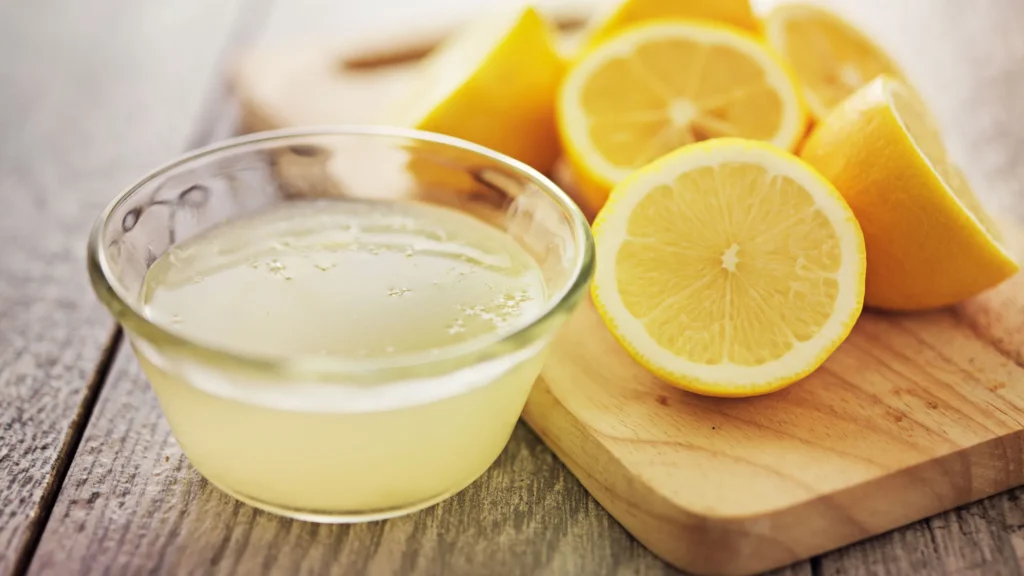
There are various ways the vitamin C in lemon juice can help in cases of angular cheilitis.
Vitamin C deficiency can cause oral infections such as this one [33].
By drinking enough lemon juice, you can help resolve this issue. You can also supply your body with its much-needed vitamin C.
Also, vitamin C is a potent wound healer, as proven in various studies [34, 35]. This is because it promotes the formation of collagen and boosts skin repair. Moreover, vitamin C strengthens the body’s immunity. So, your body becomes more defensive against microbial infections.
Try these methods of using lemon for angular cheilitis:
Method 1:
Squeeze three slices of lemon to extract the juice. Pour the juice into the water. Stir in honey. Drink lemon juice twice a day until mouth corner cracks heal.
Method 2:
Squeeze juice from one lemon slice. Apply on mouth corner cracks. This will sting a little at first. Let it sit for one to two minutes before rinsing with cool water. Repeat the remedy once a day for three weeks
12. Castor Oil
Castor oil is one of the recommended remedies by Earth Clinic for mouth corner infections.
The primary way it helps tone down angular cheilitis is by minimizing inflammation.
Several studies have confirmed its potency as an anti-inflammatory agent [36, 37].
It’s also a strong antibacterial. So, it can control the activities of bacteria that cause this problem [38]. It does the same for fungal strains that infect mouth corners [39].
Castor oil has cardiac glycosides, saponins, flavonoids, terpenoids, and tannins. These are the reasons behind its toxic effects on microbes [38].
As if all these aren’t enough, castor oil can also keep the skin around the mouth from getting dry.
How to use castor oil for angular cheilitis:
Add 2 drops of tea tree oil to ¼ tsp of castor oil. Dab a cotton ball on the oil mixture. Apply this to your mouth corner cracks. Wait for 30 minutes before rinsing with cool water. Repeat the remedy twice a day for three to four weeks.
13. Baking Soda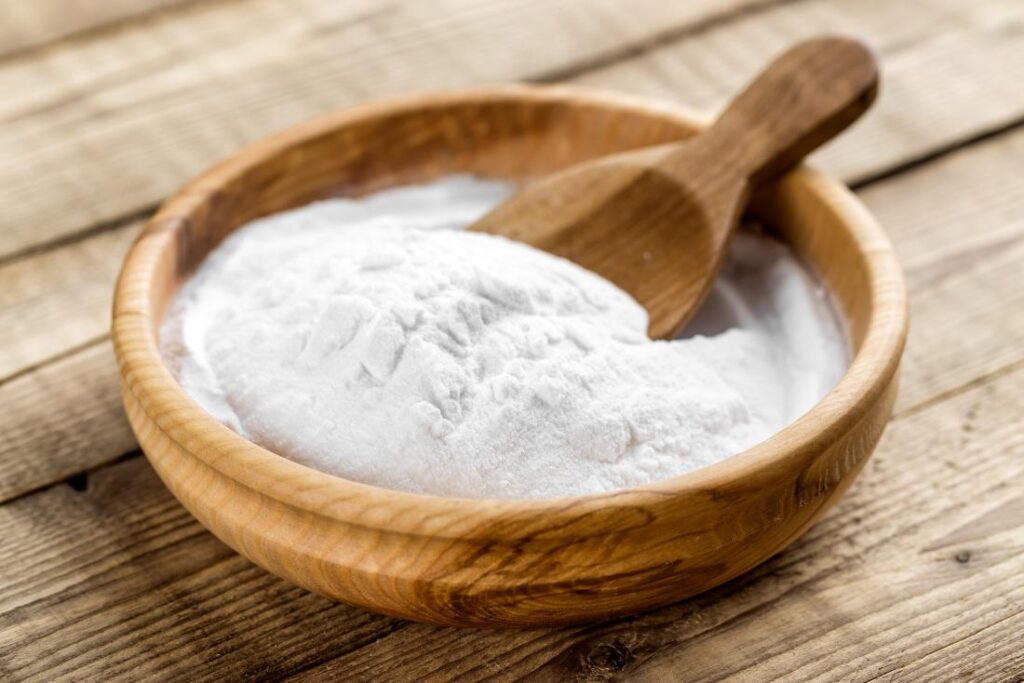
Baking soda has a versatile use for home hygiene and medicinal purposes.
Baking soda is sodium bicarbonate. That’s why baking soda is a popular rising agent for baking cakes. [40] Apart from its practical uses, baking soda has many therapeutic values. It is a potent home remedy for digestive disorders, sore throats, injuries, coughs, etc.
Baking soda contains strong antibacterial and anti-inflammatory properties. So it may cure angular cheilitis and relieve its symptoms at the earliest.
Baking soda can ward off Streptococcus bacteria, responsible for angular cheilitis infections. [41]
Let’s learn the simple baking soda method as a remedy for angular cheilitis.
Learn how to use baking soda for angular cheilitis:
Dilute 1 tsp of baking soda with water and form a thick paste. Now, apply the paste to the infectious sores. Leave the paste in the affected area for 10-15 minutes. Rinse off with clean water. Next, moisturize the affected area with coconut oil or petroleum jelly. Repeat the process 2-3 times a day to avoid irritating the sores and killing the bacteria.
Read More: How to Use Baking Soda Bath for Diaper Rash Treatment
14. Chrysanthemum Tea
Chrysanthemum tea is popular in China as an herbal tea. It’s used as a traditional Chinese medicine dates back to ancient time [42].
Chrysanthemum tea contains chlorogenic acids and flavonoids as bioactive compounds. It exhibits many antioxidant properties.
Chrysanthemum tea is a good home remedy for angular cheilitis infection. Because it contains bisabolol or levomenol, it’s a natural chemical that helps reduce pain and inflammation.
Drinking this tea soothes the digestive tract and reduces digestive tract problems. Unfortunately, these issues sometimes cause angular cheilitis infection in the first place.
Try this chrysanthemum tea recipe to get rid of angular cheilitis:
Soak the tea bag in warm water for 1-2 minutes and apply it to the affected area for 5-10 minutes. Apply this treatment twice a day to get the best results. This treatment shows the effect immediately after the first application.
15. Lemongrass Oil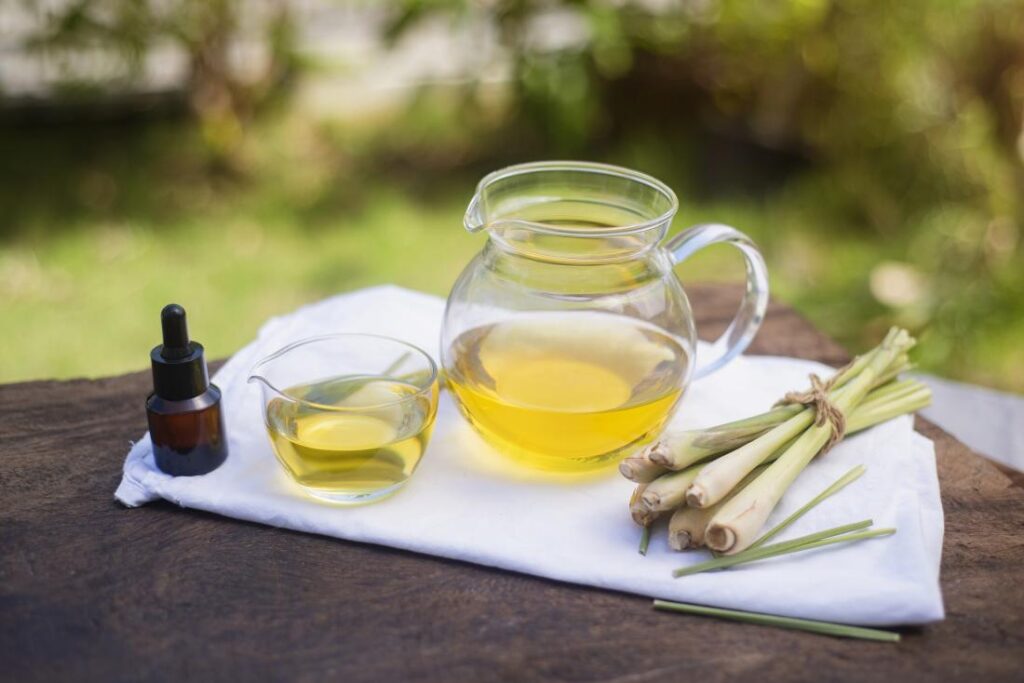
The citrusy fragrance of lemongrass is heavenly. This spiky and sharp aromatic herb is an inseparable part of Thai cuisine. Lemongrass essential oil originates from lemongrass through steam distillation. The aromatic oil has versatile uses and therapeutic benefits. [43]
Many researchers have confirmed its positive effects in fighting candida and fungi. These two are responsible for 93% of angular cheilitis cases. In addition, lemongrass oil has high astringent qualities. It is because the oil possesses two chemical compounds, terpenes and citronellal.
The bacteria and fungi thrive in a mild or neutral acidic or pH environment.
Lemongrass oil vapor may prevent these pathogens with its alkali and acidic components. In addition, the oil is not too harsh on your skin to create further irritations.
The healing touch of the oil can soothe the itch and discomforts of the angular cheilitis sores. It can also flush out all harmful bacteria and toxins of the infection.
Let’s get to know how you should use lemongrass oil.
Here’s how you may use lemongrass essential oil for angular cheilitis:
First, boil ½ cup of water. Lower the heat and add 4-5 drops of lemongrass oil to the steamy water. Lean and allow the vapor to contact your affected lips. Do this treatment 2-3 times daily. It will kill off pathogens and cure angular cheilitis infection.
16. Vitamin B
Vitamin B is an important class of water-soluble vitamins. It is a key player in cell metabolism, immune building, and energizing the body.
There are several types of vitamin B. You will find each of them in different fruits, vegetables, and meat.
You need enough of this vitamin for a healthy and active body. A deficiency of Vitamin B may weaken your immune defense. As a result, you may fall prey to all kinds of infectious diseases. Your immune power fails to fight off candida yeast because of a lack of vitamin B in the body. In addition, vitamin B deficiency causes a higher chance of suffering from angular cheilitis.
Leveling your vitamin B intake can prevent angular cheilitis and keep you healthy.
Try these methods of using vitamin B for angular cheilitis:
Method 1:
Consume Vitamin B capsule once daily. Keep the treatment on for a week to improve your immune defense against the infection.
Method 2:
Add vitamin B enriched foods to your diet. These foods include eggs, milk, red meat, liver, shellfish, salmon, tuna, chickpeas, etc.
Read More: 8 Vitamins for Acne Prone Skin That You Should Know
17. Dish Soap & Vaseline
This is one of the easiest home remedies for angular cheilitis. All you need is dish soap and petroleum jelly or Vaseline. Dishwashing soap has antimicrobial activity that can ward off a yeast infection. Vaseline can act as a protective layer.
Yeast infections such as candida thrive in moist places. Therefore, this home remedy can kill the infection, inhibit its growth, and spread to other body parts.
An easy way to use dish soap and Vaseline for angular cheilitis:
Dilute 1 tsp of dish soap with ½ cup of warm water. Now soak a cotton ball in the soap solution and clean the infected skin area. Then dry off the skin using a fresh towel. Finally, coat the angular infected skin with Vaseline to avoid moisture or dirt.
18. Yogurt
Yogurt is a great probiotic food that contains a plethora of healthy bacteria. These bacteria can fight off the invading bad microbes inside the body. You can consume yogurt in your daily meals and apply it to your mouth.
Plain yogurt can help you get rid of angular cheilitis scars too. It’s always advisable to use sour or unsweetened yogurt as a home remedy for angular cheilitis.
How to use yogurt as angular cheilitis home remedy:
Take a bit of yogurt on your fingertip and apply it to the angular cheilitis sores. Leave the yogurt on the skin area overnight. In the morning, wash off with lukewarm water and dry with a fresh towel. Repeat the treatment for a week to heal cracked lip corners fast.
Causes
The reason behind angular cheilitis is a fungal or yeast infection called candida. [2]
The growth of these pathogens occurs when the saliva gets trapped in the corner of the mouth. Licking the lips creates warmth and moisture. So, it helps the fungus to grow and multiply to cause the infection. [1]
The growth of candida or yeast infection causes that itchiness and burns around the mouth. Genetic conditions like Down syndrome and Sjögren’s syndrome can cause angular cheilitis. Nutritional deficiency is another reason behind this condition.
Who’s at Risk?
If the corners of the mouth are mostly moist, the chances of getting angular cheilitis are very high. This might even happen to people who have:
- Braces
- Dentures that don’t fit well
- The saggy skin around the mouth due to weight loss or age
- Iron or vitamin B deficiency
- Patients have diabetes, anemia, or even cancer.
When to See a Doctor
Angular cheilitis is nothing to panic about. But you can’t always deal with it at home. You must see a doctor and get treatment fast if you see the following symptoms:
- Red and purple spots on the edges of your lips.
- Excruciating pain.
- Dryness with a burning sensation.
Final Word
Angular cheilitis can hamper your daily life. Still, you should not worry about it too much.
You can end the pain and infection by using these simple and effective home remedies for angular cheilitis.
These natural remedies will not heal angular cheilitis overnight. But these remedies can reduce the symptoms to a great extent.
Plus, these home remedies may help you to get rid of angular cheilitis safely.
Most of these do not cause any harmful side effects as long as you follow the proper directions.
READ NEXT: 13 Home Remedies for Mouth Ulcer That Work
